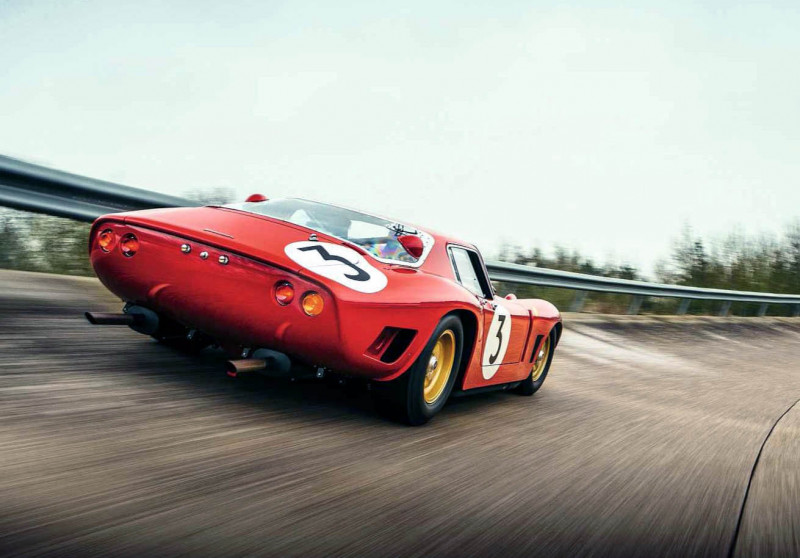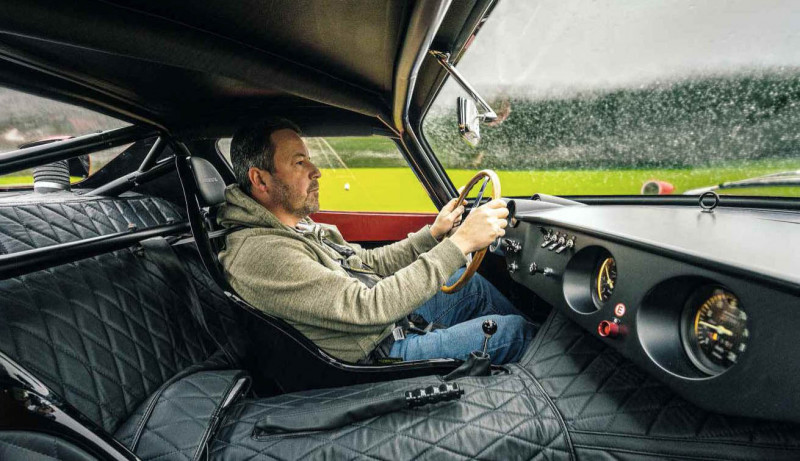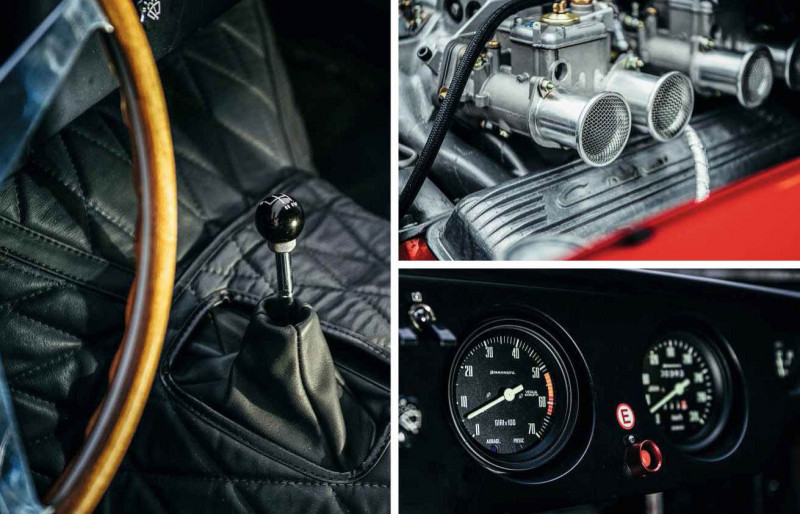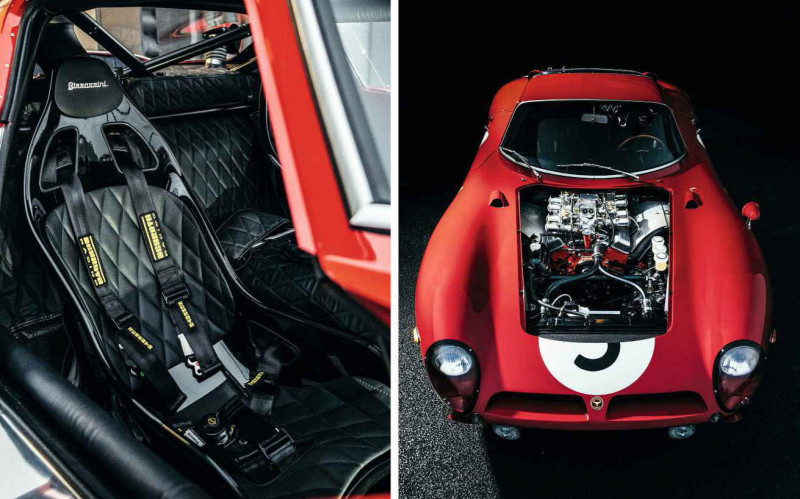2023 Bizzarrini 5300 GT Corsa Revival
One of the most desirable race cars of the 1960s is back for a limited run, with road legality a tantalising prospect.
When it comes to Italian exotica few cars boast a more evocative name or more mythical status than the Bizzarrini 5300 GT Corsa. Born out of a beef with Enzo Ferrari — boy did that man have a knack for making enemies — this low, lithe and lasciviously curvy machine was the brainchild of a dazzlingly talented engineer by the name of Giotto Bizzarrini. To understand the car you have to understand the man, so before we get under the skin and behind the wheel of the 5300 GT Corsa Revival, let me offer a bit of a history lesson.

Bizzarrini made his mark well before embarking on his eponymous venture: first at Alfa Romeo, where he worked as a test driver and engineer in Alfa’s skunkworks, before being headhunted by Enzo Ferrari.
Once at Maranello he was pivotal to the design of both the 250 SWB and 250 GTO, but in 1961 he and a handful of other key players were sacked by the curmudgeonly Old Man in what is referred to as the Palace Revolt. As a gun for hire, Bizzarrini grasped every opportunity to become a thorn in Ferrari’s side — a quest embraced by many of Enzo’s rivals.

Indeed, it was Bizzarrini who Ferruccio Lamborghini commissioned to design the company’s first V12 engine, evolutions of which powered every 12-cylinder Lamborghini from the 350 GT in 1963 to the Murcielago in 2010.
Still only in his late-30s, Bizzarrini continued to push the boundaries, further evolving front- engined GT ideas he’d developed during the 250 GTO programme and later with the one-off 250 GT ‘Breadvan’. It was when Italian industrialist Renzo Rivolta enlisted Bizzarrini and his Societa Autostar engineering consultancy to work on developing sports cars for his intriguing Iso brand that the vision of a truly low-line, lightweight, low-drag machine would fully crystallise, in the magnificent form of the Iso Grifo A3/C.

The A3/C was an extreme evolution of the Iso Grifo A3/L (L for Lusso) road car, which Bizzarrini also designed. A racer at heart, Bizzarrini believed there would be demand for a competition version, so once the A3/L design was defined he set to work on the A3/C (C for Corsa), which he would come to describe as his ‘improved GTO’. Both cars would make their debut at the 1963 Turin Motor Show.
Each was a stunning machine, but the A3/C was truly sensational, its lightweight bodywork originally made from exotic Avional alloy (later cars switched to glassfibre) and styled by Giorgetto Giugiaro in his time at Bertone. With refinements applied by Piero Drogo’s Carrozzeria Sports Cars — a firm responsible for numerous one-off coachwork commissions and some of the most memorable Ferrari competition cars of the '60s — the Grifo A3/C was an Italian thoroughbred with a pounding Detroit heart.

With plenty of grunt from Its 5.3-litre Chevrolet ‘327’ small block V8- an engine Bizzarrini himself said was more responsive than Ferrari’s V12 — and the motor set low and 40mm further back in the chassis for a groundskimming centre of gravity and perfect balance, it was a truly state-of-the-art machine.
While Iso focused on productionising the road-going A3/L, Bizzarrini concentrated his efforts on developing the A3/C, with a prototype version making a troubled debut at Le Mans in 1964. Production of the Grifo road car commenced the following year, but the collaborative union between Rivolta and Bizzarrini had begun to crumble. The pair would eventually go their separate ways later that same year, but not before an Iso Grifo A3/C won its class and placed ninth overall in that year’s Le Mans 24 Hours.
In the fallout from his departure from the Iso project, Bizzarrini founded his eponymous marque, initially building variants of the Grifo A3/L and A3/C called the 5300 GT Strada and 5300 GT Corsa. Over the next five years the company would produce aseries of sparkling cars, ranging from the extreme open-cockpit P538 sports prototype from 1966, which was also penned by Giugiaro and powered by a choice of Chevy V8 or Lamborghini V12, to the petite 1900 GT Europa of 1967 — Bizzarrini's far-sighted effort at an entry-level model, which weighed just 650kg and was powered by a 2.0-litre four- cylinder Opel engine.
Sadly, by 1969 Bizzarrini SpA filed for bankruptcy. Subsequent false starts and low-key one-off commissions followed, but it seemed this incendiary name would forever remain a footnote in the history of Italian exotics. That is until 2018, when the trademarks and intellectual rights to the Bizzarrini marque were acquired by Kuwaiti-owned Pegasus Brands.
Led by Rezam Mohamed Alroumi, Pegasus has big-league funding and a successful track record in the high-end automotive industry, most notably through its international dealership business in which it represents Aston Martin, Rolls-Royce and Koenigsegg amongst others. Pegasus also owns a significant stake in Aston Martin Works, with Alroumi previously playing a pivotal role in the group of international investors who purchased a majority stake in Aston Martin Lagonda back in 2007.

The new Bizzarrini is a serious venture. One which begins with a limited run of the car you see here, the 5300 GT Corsa Revival, but is driven by people who are serious about bringing Bizzarrini to prominence as a maker of exceptional contemporary cars. Cars which promise not to follow the well-trodden hypercar recipe, and instead feel closer in spirit to those from Pagani.
The first all-new car — currently known only as ‘Project CT — is already well underway, with styling by Giugiaro. Further exploration of the Bizzarrini back catalogue is also likely, in conjunction with an expansion of the contemporary model portfolio that promises to explore a variety of powertrain options that celebrate the past and acknowledge present and future environmental challenges. Bold promises are commonplace at this end of the market, but the quiet yet insistent way Bizzarrini is going about its business feels different.
And so to the 5300 GT Corsa Revival. Built to celebrate Bizzarrini’s most famous car and its greatest motor racing success, just 24 Revivals will be built. Using original Bizzarrini blueprints it is a remarkably faithful reproduction of the 1960s masterpiece, albeit with some concessions to modern safety requirements and the adoption of some 21st century materials.
The project is being handled by RML Group (yes, them again), which is enjoying something of a purple patch as the go-to solution for whole-vehicle engineering projects. Using a dedicated standalone building adjacent to the RML Group campus, Bizzarrinis are painstakingly fabricated and built by hand in a mix of time-honoured artisanal methods and state-of-the-art precision, quality control and project management.
True to Giotto Bizzarrini’s forward thinking, the 5300 GT Corsa was a highly advanced machine in its day. Its welded steel lower structure was light and strong while its independent suspension all-round was a significant step on from the 5300 GT Strada, which used a de Dion rear axle. Disc brakes at each corner provided decent stopping power for the day — important when slowing this slippery GT from speeds upwards of 180mph at Le Mans.
Rather than Avional or glassfibre, the Revival uses carbonfibre for its bodywork. Given Bizzarrini’s love of advanced methods, this feels in keeping with his ethos and ensures the Revival’s bodywork is strong, light and beautifully finished. It’s a one-piece body — surely one of the largest of its kind — that drops onto the steel lower structure like a 1:1-scale Tamiya model. To increase safety the original steel structure is supplemented by an FIA-approved roll-cage. Likewise the fuel tank is now a modern bag tank situated behind the driver and passenger and not located in each sill like in the original design.
In every other respect the 5300 GT Corsa is a time-warp creation. It really is jaw-droppingly gorgeous, the endless teardrop curves, hip-high roofline and almost horizontal rear screen combining to create a form quite unlike any other car from its day. Race car details add to the wonder, from those perfectly faired-in headlamps beneath fulsome Perspex bubbles to the slots, vents and scoops that draw air into and out of the machine. Centre-spline cast magnesium wheels attached with throwing-star spinners are the cherries on top.

The cockpit is equally period-perfect. The instruments are deployed in eccentric fashion, temperature and pressure gauges immediately ahead of you while the all-important tacho is set in the middle of the dash, right at the edge of your peripheral vision. Quilted black leather wraps the broad transmission tunnel, which is topped by a surprisingly petite gearlever. This controls the Borg Warner four-speed ’box, the shift quality of which is workmanlike, though as with all analogue cars its operation improves with practice and positive inputs.
With the engine set so far back, you sit much closer to the rear axle than you do the front. Legend has it that when Bizzarrini mechanics had to adjust the V8's timing they did so via an access panel on top of the dashboard rather than going in through the bonnet. It really is a fabulous place to sit. Somewhat sobering, too, when you consider in original cars you basically had a Corvette motor on your lap and a pair of huge fuel tanks slung from your hips.
Start the engine and that sense of being in the belly of the beast is intensified with the chatter of the transmission, the thrash of engine pulleys and the suck and snort from the bank of hungry 45 DCOE Weber carburettors. As tested this development Corsa Revival’s motor is running a soft state of tune, though all things are relative. In this case ‘soft’ is circa 400bhp, with the emphasis being a smooth, tractable spread of power and torque. A race-tuned engine built to comply with FIA historic racing regulations would be somewhere between 460 and 480bhp, but would come with a more aggressive and potentially recalcitrant delivery that would have little patience for anything other than maximum attack.
Visibility is hardly panoramic, but what you see through the windscreen is highly inspiring, with the tops of those endless front wheelarches stretchingout ahead of you, the left-hand panel topped with a bullet wing mirror that affords you a reflective porthole with which to survey the rising rear haunch and, er, not much else.
Being a race car — albeit one trimmed for perfect period effect — the Corsa is a noisy beast, the engine and transmission joined by the sound of suspension joints and the tight Salisbury mechanical limited-slip differential. It’s a raw mechanical cacophony, but the feel of the car is anything but crude. In fact it’s surprisingly modern in terms of rigidity and the ability to position it accurately on the road, or in our case Millbrook Proving Ground’s Outer Handling Circuit and Alpine Route.
The additional bracing offered by the roll-cage makes a difference, but the fundamentals of the Bizzarrini mean it’s a world away from that other great American V8-powered racer of the ’60s, the Shelby Cobra. Where that car is an unruly and overpowered amalgam of lightweight alloy bodywork and overwhelmed leaf springs, the 5300 GT Corsa feels beautifully balanced and well able to deploy its ample performance.
At 1250kg the Revival is within a spit of the original in terms of mass, positioning this near- 60-year-old machine at current-generation Porsche 911 Carrera GTS levels of power-to- weight. No, the performance isn’t as accessible, but honestly that’s the point — and appeal — of cars such as this. Besides which, the intrinsic rightness of Bizzarrini’s design is evident in everything the car does, not to mention its nearperfect corner weighting, which sees 25 per cent of the car’s mass sit evenly on each wheel.
Consequently, not only does it have a brilliant combination of agility and stability, but it also has a consistency and progressiveness of response that’s uncommon in cars from this era. Of course, the great caveat is set-up. This car isn’t dialled-in for edgy ultimate pace, rather it’s tuned for occasional trackday use in the hands of an enthusiastic collector. I have no doubt it would be absolutely sensational to drive the Corsa Revival hard somewhere blessed with the kind of fast, open curves that offer the opportunity to get it where every ’60s racer needs to be — just beyond its limit of grip.
All 24 Corsa Revivals will be finished in this same red-and-gold scheme, which mimics that of the ’65 Le Mans class winner. The first customer car is due to be completed in a matter of weeks, with subsequent cars following every few weeks until the production run is completed.
The RML connection brings an added dimension to the Revival programme, too, for although the Corsa is clearly a race car by design, it can be a road car when successfully put through the IVA process — something RML knows better than most, having masterminded that same process for Aston Martin customers who wished to make their DB4 GT and Zagato Continuation cars fully road legal. I’d certainly take a road-legal Corsa Revival over most modern hypercars.
What price this perfectly wrought evocation of’ 60s Italian exotica? In the UK, £1.65million including taxes. Yes, that’s a ton of money (actually a little more than examples of the original car), but it’s worth it on looks alone. If you have the means to buy one, I suspect the asking price would be immaterial after your first meaningful test drive.
It’s fair to say history regards the 5300 GT Corsa as Giotto Bizzarrini’s finest creation. Whether the reborn Bizzarrini brand can top it with any of its forthcoming clean-sheet efforts remains to be seen. What’s beyond doubt is that the 5300 GT Corsa Revival is a compelling preface to what will hopefully be a long and unfolding story that finally does his name and engineering genius justice.
TECHNICAL DATA2023 Bizzarrini 5300 GT Corsa Revival
- Engine V8,5363cc
- Max Power 404bhp
- Max Torque 488lb ft
- Weight <1250kg (c327bhp/ton)
- 0-62mph 3.9sec
- Top speed 190mph
- Basic price £1,650,000
- + Delivers an authentic 1960s Bizzarrini experience
- — Requires deep pockets
- DrivesToday rating 5/5
Left: bodywork is now carbonfibre, but otherwise closely replicates that of the originals; magnesium wheels conceal uprated disc brakes at each corner.
Left: 5.3-litre V8 is equipped with Weber 45 DCOE carbs (above left) and is good for over 400bhp in its mildest state of tune, with 480bhp achievable.
Above: Meaden travels back in time; race-grade rollcage and revised steering column construction among measures to improve safety beyond 1960s standards


